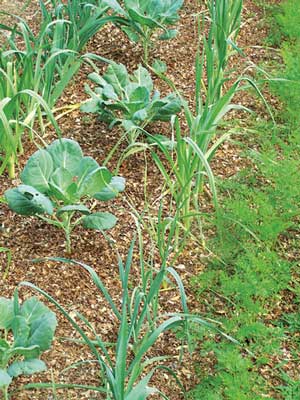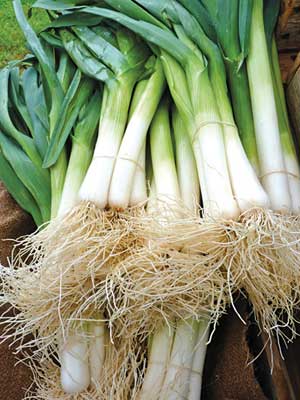 |
| Young leeks interplanted with carrots and brussels sprouts. Will Bonsall photo |
 |
| The leek “stalk” is a sheaf of elongated leaves bound tightly at the base by the root crown. English photo |
By Will Bonsall
Some academic friends of mine were on sabbatical in southern France when their checks failed to arrive as expected. Weeks went by before the mistake was corrected, during which time they were on their own, making shift as one might. They found an abundance of wild leeks in the neighborhood and subsisted largely on them for a while. They later told us that story as proof of how dire their situation was, but given my feelings about leeks, I confess my sympathy was rather half-hearted.
Much as I do love onions and garlic, somehow they are just not as satisfying as leeks, especially accompanied by a bit of bread or potato. I suppose the ancient Israelites felt much the same way when they fled slavery in Egypt. Hardly arrived in the “freedom” of the wilderness, they start right in kvetching at Moses about their manna-based diet. Sure, send us back to the brick-pits, feed our newborn to the crocodiles, but please, oh please don’t take away our leeks. (In fairness their food-lust also extended to onions and melons.) Yeah, I totally get it.
Fact is, the two locales I’ve just mentioned – Egypt and southern France – are generally recognized as the ancestral homelands of leeks. That’s where they were first domesticated, so it’s not surprising that wild leeks still abound in both regions.
From these weedy populations came two general types of the cultivated leek, Allium ampeloprasum: summer leeks and winter leeks. The former are more common in the Mediterranean basin, where they form a long, slender, light-green shaft that is actually very cold-hardy, just not as much as the winter-types. The latter are shorter and stouter with darker blue-green leaves that tend to stick out sideways. That blue-green pigment is essentially a natural antifreeze, which allows the plant to withstand heavier freezes than the summer leeks. Both types often overwinter in my not-banana-belt western Maine garden, although winter leeks sustain less injury and waste.
Leek stalks are often banked with earth or straw mulch to exclude light from the lower stalks, making them blanched and tenderer. For my money that’s a lot of work for little benefit; I’m not allergic to chlorophyll. When I used to depend on eating leeks only fresh from the garden, I preferred the hardier winter types for an extended season. Now that I store chopped leeks in the freezer or dehydrated, that’s less important, and I think the summer leeks do better with less concentrated nitrogen, plus their upright habit fits better with companion crops – kale being my favorite.
While the leek is very big in Welsh cuisine (it’s even their national emblem), the so-called “Welsh onion” is a totally different critter from leeks and even from true onions (A. cepa). Actually it’s Japanese (Allium fistulosum), and while quite nice to eat, it’s just not leeks. On the other hand, so-called Elephant garlic in fact is a leek that forms a very large, garlic-like bulb with a much milder flavor. Very nice, but if you prefer rich garlic flavor, grow garlic.
The confusion is perhaps doubly forgivable when you consider that the name “leek” comes from the Old English/Anglo-Saxon “laek,” which also pops up in “garlic” (gar-laek = “sword-leek”).
For what it’s worth, what we call a leek “stalk” is not really a stalk but a sheaf of elongated leaves bound tightly at the base by the root crown. The significance of this is that if you cut the leek just above the ground, it kind of goes to pieces on you. On the other hand I do like to trim off most of the diffuse roots to get rid of as much soil as possible. That, incidentally, is another argument against banking leeks: the nuisance of cleaning the shafts for eating. By the way, leeks may be stored in buckets for several months for fresh eating; in this case, keep much of the soil on the roots and dampen them if and when necessary so that the leeks don’t wither gradually.
When folks prepare leeks for market, they typically trim off much of the long, floppy, green upper leaves (“flags”) as they just wilt and are unattractive. However they’re not altogether useless despite their fibrousness. They may be too tough for a vegetable, but I chop those parts and dehydrate them on a screen rack (preferably nylon) hung over the cook stove. When they are brittle-dry, I run them through my Corona grain mill (adjusted so that they don’t gum up the plates) and out comes a brilliant jade-green powder. I may use this in soup stocks but mostly I steep this in a bottle of vegetable oil along with crushed and sifted dried celery leaf (the dark part you throw away), homemade garlic powder and paprika, and maybe some kelp powder. To this I add a roughly equal amount of tamari and set it in the fridge for a week or more. Sprinkled on popcorn – shake it every time – this will turn a long evening of watching your neighbors’ vacation video into a captivating experience.
In milder climates people sometimes plant leeks as a late fill-in crop after an earlier crop, such as peas or lettuce, has been removed. I find I need my entire short season to mature a good crop of nice fat leeks. In fact I never direct sow them, but start them in flats indoors like onions, or in covered coldframes. For several years now I have started both onions and leeks in #72 cell-trays thinned to three or four plants per cell. With leeks I set the plants out by mid-May with about 8 inches between clusters (more like 12 inches for onions). These are in 4-foot-wide beds each containing two leek rows, each row 24 inches to either side of the bed’s center line. Later I transplant three rows of kale seedlings into that bed from a nearby, densely-seeded nursery plot. One of the three kale rows is planted on the center line, 12 inches from either of the two leek rows, with another kale row to either outside of the leeks. This makes five rows in all, each 12 inches apart, with kale-leeks-kale-leeks-kale. The leeks need a good head start lest they be overwhelmed by the vigorous and shady kale. I’ve also reversed that sequence when I desired more leeks than kale. Since kale sets don’t get transplanted until mid-July, I have sometimes preceded that by an early lettuce crop, also transplanted as early as the leeks.
It has become trendy to sell “baby leeks” along with other “baby vegetables,” and that may be an appropriate way to use an empty space that doesn’t have time to mature a full-season crop (like leeks?). I guess the assumption is that such baby veggies are exceptionally tender, like vegetable veal, but in the case of leeks that’s not so true. In fact it is in the late stages of growth that leeks make their most rapid and tender growth with the least percentage of tougher upper leaves, not to mention the greater waste from trimming the little plants, so while I certainly will use the pencil-sized culls from my regular crop, if I want a filler-crop from a short-season empty spot, I prefer one of the quick-maturing clonal onions such as multiplier or top-set onions (see my article “Onions that Fit” in the summer 2015 issue of The Maine Organic Farmer & Gardener).
Some folks like to use chopped raw leeks in salad, and I agree they look wicked cunnin’ but they are tougher than I prefer, whereas slow cooking best develops their warm flavor and texture.
I’m aware of three leek pests (not counting humans like myself, who can consume a whole crop leaving nothing behind), and although I probably have them all, I haven’t noticed any of them: leek rust, leek moth and leek thrips. Supposedly the thrips (Thrips tabaci) also attack cabbage family crops, so my companioning with kale would seem to present a double jeopardy, yet I’ve seen no sign of a significant problem. (I do have thrips in my onions, but supposedly a different kind.) In any case I didn’t choose kale/leeks for any repellent properties of either, such as flea beetles, but because their plant forms and soil needs seem to fit well together. Moreover I’ve been impressed at how often crops that are compatible on my plate are also compatible in the soil.
I read of a Polish study in which intercrops of clover and/or carrots with leeks reduced thrips by 50 percent, apparently with little reduction in leek yield due to competition. Interplanting green beans even more effectively deterred thrips, yet reduced the leek yield considerably. Of course such a study must take into account the offsetting value of the bean crop.
Leeks have moderate fertility demands, but more than to nitrogen, they seem to respond well to abundant humus and ample watering, especially early in the season. They really seem to appreciate a mulch of shredded leaves, as does their kale companion.
Leeks are a strong biennial; that is, they never try to “bolt” to seed in their first season (like some beets and chards do). They know they need to build up a certain plant mass and become well established before they move on to the sexual stage. In fact I’ve noticed that while undersized plants may go to seed as expected in their second year, their seed yield is usually poor. They seem to realize that themselves, and instead of giving up and dying after that – like most biennials – some plants may survive to a third season and try again, often with better success. It’s almost like they never completely abandoned the perennial option.
How do I use leeks in the kitchen? They’re fine just steamed plain, but I typically combine them with something like kale and potatoes and celeriac or parsley to make a creamy soup. The “creamy” comes from a bit of oat flour, pre-cooked soy flour, and pepita meal (see my “Oilseed Pumpkins” article in the winter 2012-2013 issue of The Maine Organic Farmer & Gardener) cooked into a broth that I add to the steamed veggies. Not too shabby, especially on a cold winter evening.
Beyond rich flavor, what do leeks offer us? Although rather low in fuel carbohydrates, they are packed with a dazzling spectrum of vitamins and minerals. The latter include potassium, calcium, magnesium, iron, copper and manganese, while they are very good sources of vitamins A, B6, C and E, and omega-3 fatty acids. Like other alliums they are loaded with sulfur-containing allicin, which, whether you like it or not, is downright good for you – antibacterial, antiviral and antifungal. They also reportedly neutralize dangerous free radicals; although I consider myself a free radical, somehow I’m not offended at this. They contain lots of a flavonol called kaempferol, which is antioxidant, anti-inflammatory, antimicrobial, anticancer, anti-osteoporotic and anti-allergic. I suspect they are also anti-establishment. And they protect your heart and nervous system, and improve your singing voice. At least that’s what the Roman emperor Nero believed: He ate oodles of leeks to maintain his beautiful singing voice, although history is mute on the effectiveness of that.
Make what you want of all this good-for-you stuff, but loving the warm, friendly flavor and feel of leeks as I do, I’m just going to keep eating them anyway.
About the author: Will Bonsall lives in Industry, Maine, where he directs Scatterseed Project, a seed-saving enterprise. He is the author of “Will Bonsall’s Essential Guide to Radical Self-Reliant Gardening” (Chelsea Green, 2015). You can contact Will at [email protected].
